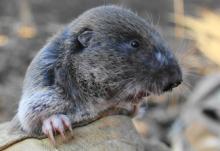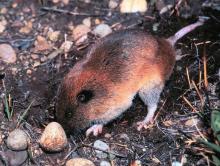Species: Thomomys mazama
Western Pocket Gopher
Species
Encyclopedia of Puget Sound
Articles:

This article was originally published by the Washington Department of Fish and Wildlife as part of its annual report Threatened and Endangered Wildlife in Washington.

Classification
Kingdom
Animalia
Phylum
Craniata
Class
Mammalia
Order
Rodentia
Family
Geomyidae
Genus
Thomomys
NatureServe
Classification
Other Global Common Names
Mazama Pocket Gopher
Informal Taxonomy
Animals, Vertebrates - Mammals - Rodents
Formal Taxonomy
Animalia - Craniata - Mammalia - Rodentia - Geomyidae - Thomomys - .
Ecology and Life History
Migration
true - false - false
Non-migrant
true
Locally Migrant
false
Food Comments
Eats roots, tubers, bulbs and some surface vegetation. Forages from underground burrows. May also forage on the surface of the ground at night or on overcast days. Collects food in cheek pouches and stores it in underground storage chamber.
Reproduction Comments
Gestation lasts about 28 days. Females produce 1 litter of 4-6 young each year. Young are born in March-June.
Ecology Comments
Primarily solitary. Predators include owls, coyotes, and bobcats. Pocket gophers are ecologically important as prey items and in influencing soils, microtopography, habitat heterogeneity, diversity of plant species, and primary productivity (Huntly and Inouye 1988).
Length
24
Weight
96
Conservation Status
NatureServe Global Status Rank
G4
Global Status Last Reviewed
2008-08-22
Global Status Last Changed
2005-11-14
Distribution
Conservation Status Map
<img src="http://www.natureserve.org/explorer/servlet/GetMapGif?US.CA=SNR&US.OR=SNR&US.WA=S2" alt="Conservation Status Map" style="width: 475px; height: auto;" />
Global Range
FG - 20,000-2,500,000 square km (about 8000-1,000,000 square miles) - FG - Northwestern Washington through western and central Oregon to northern California (Verts and Carraway 2000).
Global Range Code
FG
Global Range Description
20,000-2,500,000 square km (about 8000-1,000,000 square miles)


